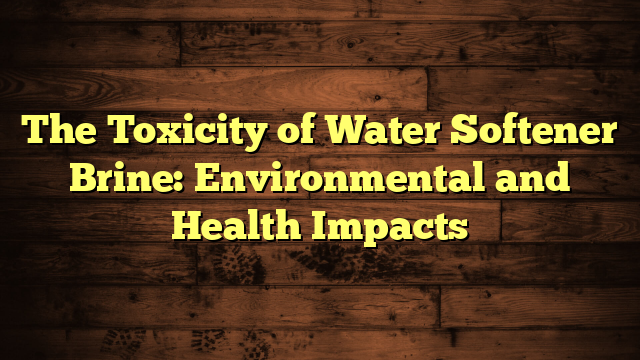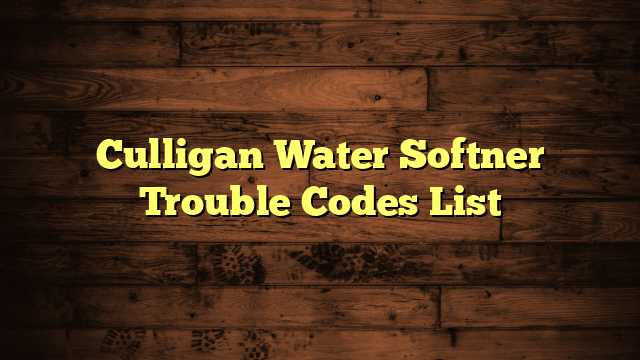The Toxicity of Water Softener Brine: Environmental and Health Impacts
You might not realize it, but the brine from water softeners can have serious implications for both our environment and health. When improperly disposed of, this sodium-rich solution can seep into waterways, increasing salinity and threatening aquatic ecosystems. Furthermore, the elevated sodium levels in drinking water can pose risks, particularly for those with pre-existing health conditions. Understanding the full scope of these impacts is vital, yet many remain unaware of the hidden dangers associated with this common household product. What are the best ways to address these issues and protect both our health and the environment?
Key Takeaways
- Water softener brine contains high sodium levels, exceeding 1,000 mg/L, posing risks to aquatic ecosystems and human health.
- Improper brine disposal increases salinity in water bodies, leading to habitat disruption and reduced biodiversity among aquatic organisms.
- Elevated sodium in drinking water from brine can cause health issues, particularly hypertension and cardiovascular problems in sensitive populations.
- Brine's high salinity negatively affects soil health, hindering plant growth and increasing risks of groundwater contamination.
- Regulatory measures and community initiatives are essential for managing brine discharge and promoting sustainable water treatment solutions.
Understanding Water Softener Brine
Water softener brine is a concentrated solution of salt, typically sodium chloride, that's vital for the water softening process. The brine composition varies depending on the type of softener you use, which can greatly impact its effectiveness.
Most commonly, you'll find two softener types: ion-exchange and salt-free systems. Each type has its specific brine requirements, adapting to different water hardness levels.
In ion-exchange systems, the brine replenishes the resin beads that remove hardness minerals like calcium and magnesium from your water. The sodium in the brine effectively replaces these minerals, resulting in softer water.
On the other hand, salt-free systems often use potassium chloride instead of sodium chloride, offering a different brine composition that can also reduce scale buildup without using traditional salt.
Understanding these differences is essential for choosing the right system for your home. You'll want to take into account not only the brine composition but also how it aligns with your water quality needs.
Environmental Consequences
Many homeowners underestimate the environmental consequences of disposing of water softener brine.
The brine, which contains high levels of salt and other chemicals, can lead to significant ecological harm if not managed correctly. It's essential to understand how improper brine disposal methods contribute to salt pollution and affect local ecosystems.
Here are three key environmental consequences you should consider:
- Water Contamination: When brine enters water bodies, it raises salinity levels, harming aquatic life and altering ecosystems.
- Soil Degradation: Excessive salt in the soil can hinder plant growth, reducing agricultural productivity and affecting food supply.
- Infrastructure Damage: High salinity can corrode pipes and other infrastructure, leading to costly repairs and increased maintenance.
Health Risks Associated
The brine produced by water softeners poses several health risks that homeowners often overlook. This brine, primarily composed of sodium and chloride, can have significant health implications for you and your family.
When this salty effluent enters your drinking water supply, it raises sodium levels, which can be especially concerning for those with hypertension or heart issues. You mightn't realize that elevated sodium intake can lead to increased blood pressure, putting you at greater risk for heart disease or stroke.
Additionally, the brine composition can disrupt the balance of essential minerals in your water, potentially causing deficiencies that affect your overall health.
In addition to sodium, the brine might contain contaminants from the water supply, which can further pose risks if ingested. For instance, certain heavy metals or chemicals could be concentrated during the softening process, leading to harmful health effects over time.
It's essential to be aware of these health risks associated with water softener brine. By understanding the implications, you can make informed choices about your water treatment options and protect your family's health.
Impact on Aquatic Life
When you think about water softener brine, consider how its high salt concentration can considerably disrupt aquatic habitats.
Elevated salt levels can stress or even kill sensitive species, leading to a decline in biodiversity. As these ecosystems become unbalanced, the consequences ripple through the food web, affecting everything from tiny microorganisms to larger aquatic animals.
Salt Concentration Effects
Rising salt concentrations in water bodies profoundly affect aquatic life, disrupting ecosystems and threatening biodiversity. You mightn't realize it, but the salt effects of water softener brine can lead to significant concentration impacts on various species. Freshwater organisms, such as fish and amphibians, are particularly sensitive to these changes, creating a ripple effect throughout the ecosystem.
Here are three critical ways increased salt levels can harm aquatic life:
- Osmoregulation Issues: Many aquatic species struggle to maintain their internal salt balance, leading to stress or death.
- Reduced Species Diversity: Higher salt concentrations can favor salt-tolerant species, pushing out more sensitive organisms and reducing biodiversity.
- Altered Food Webs: Changes in species composition can disrupt food chains, affecting everything from microorganisms to larger predators.
As you can see, the concentration impact of salt in our waterways isn't just a matter of taste; it's a pressing environmental concern.
You can help by advocating for better water management practices and supporting policies that minimize salt discharge. Protecting aquatic life means preserving the delicate balance of our ecosystems for future generations.
Habitat Disruption Consequences
How does habitat disruption due to increasing salt levels affect aquatic life? When you introduce excessive salt from water softener brine into natural water bodies, it can lead to significant ecosystem imbalances.
Many aquatic organisms, including fish and invertebrates, can't thrive in high-salinity environments. This disrupts their life cycles and can result in reduced populations. For instance, species that are sensitive to salinity changes may migrate to other areas, seeking more favorable conditions.
However, this species migration can lead to overcrowding in less impacted habitats, further straining resources and creating competition.
Moreover, as native species leave, invasive species may take their place, compounding the problem and altering the food web. This disruption doesn't only affect individual species; it can ripple through the entire ecosystem, leading to a decline in biodiversity.
Healthy aquatic ecosystems rely on a delicate balance, and when that balance is disrupted, the consequences can be severe, including the loss of critical habitats and the decline of fisheries.
Understanding these impacts emphasizes the importance of managing salt levels and protecting aquatic environments for the sake of all living organisms.
Regulatory Guidelines
Regulatory guidelines surrounding water softener brine are essential for protecting both the environment and public health.
These guidelines establish regulatory standards that help mitigate the harmful impacts of brine discharge into our water systems. By adhering to compliance measures, communities can greatly reduce the risks associated with increased salinity in freshwater resources.
Here are three key components of effective regulatory guidelines:
- Monitoring and Reporting: Regular assessments of brine discharge levels must be conducted to verify they remain within safe limits. Consistent reporting helps authorities track compliance.
- Discharge Limits: Establishing specific salinity thresholds for brine discharges guarantees that water bodies don't become overly saline, protecting aquatic ecosystems and drinking water sources.
- Treatment Requirements: Implementing treatment solutions for water softener brine before it's released into the environment can help minimize its toxic effects.
This involves using technologies that can remove or neutralize harmful components.
Sustainable Alternatives
Many homeowners are seeking sustainable alternatives to traditional water softeners that produce harmful brine. You might consider eco-friendly solutions like salt-free water softeners, which use a process called natural water conditioning.
These systems help reduce scale buildup without the use of harsh chemicals, making them gentler on both your plumbing and the environment.
Another option is the use of magnetic or electronic descalers. These devices alter the structure of minerals in your water, preventing them from forming scale while leaving the water mineral content unchanged.
This method not only minimizes environmental impact but also maintains the beneficial minerals your body needs.
If you're inclined towards DIY solutions, vinegar and baking soda can effectively clean your fixtures and appliances.
While these won't soften water in the traditional sense, they can help manage scale buildup naturally.
Lastly, rainwater harvesting is another sustainable approach. By collecting and using rainwater for irrigation or non-potable purposes, you can reduce your reliance on softened water altogether.
Exploring these alternatives can lead to healthier choices for both your home and the planet, ensuring you contribute positively to environmental conservation.
Frequently Asked Questions
How Does Water Softener Brine Affect Soil Quality?
Water softener brine can harm soil quality by introducing brine toxicity, leading to soil contamination. This impacts nutrient availability and microbial health, ultimately affecting plant growth and the overall ecosystem health in your garden.
Can Water Softener Brine Be Recycled or Treated?
You can explore brine recycling and brine treatment methods to reduce environmental impact. Techniques like evaporation or crystallization help reclaim valuable minerals while minimizing waste, making your water softening process more sustainable and eco-friendly.
What Are the Signs of Water Softener Brine Exposure?
Have you ever wondered what brine exposure symptoms could mean for your health? You might experience nausea, headaches, or skin irritation, all potential health risks that shouldn't be ignored. Stay alert and seek medical advice if needed.
Are There Alternatives to Salt-Based Water Softeners?
Yes, there are alternatives to salt-based water softeners. You can consider magnesium-based alternatives or potassium chloride options. Both effectively soften water while reducing environmental impact and avoiding some issues associated with traditional salt systems.
How Can Individuals Minimize Brine Pollution at Home?
Think of a garden thriving under a gentle rain. You can minimize brine pollution by embracing rainwater harvesting and choosing eco-friendly alternatives, nurturing your environment while protecting precious water resources for future generations.
Conclusion
In our quest for comfort, we often overlook the irony that our water softeners can harm the very environment we cherish. The risks associated with water softener brine, from ecological disruption to health complications, highlight the need for responsible management and sustainable alternatives. By acknowledging these consequences, you can take action to protect both your health and the planet. After all, a little salt is great on food, but not so much in our waterways.







